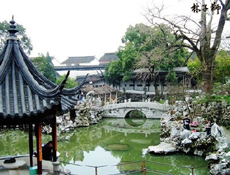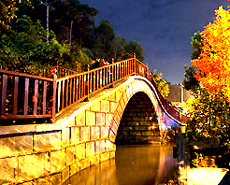Sleek, white and angular. Such was the day's theme. It began with me sauntering along Platform 5 at Shanghai train station, where a gleaming new space-age CRH (China Railways High-Speed) bullet train was to take me to Suzhou. Its tapered nose and curvaceous white shell were complemented in the interior by large airline-style seats that recline to a position pleasing even to business-class frequent fliers.
Thirty minutes later, the hi-tech white snake slipped effortlessly out of Suzhou's dusty station, depositing me in the midst of China's new reality: ongoing metropolitan development guided by a need to confront the demands of the future without needlessly stopping off in the present.
Suzhou is a study in 21st-century urban planning, one that graduate students from Canberra to Kansas will no doubt discuss for decades. Three key issues dominate the debate: economic growth, urban migration and tourism overload. What goes around comes back around, and one of China's most affluent, culturally rich and technologically advanced cities during the Ming and Qing dynasties desires to sit once again at the top table. Hence, a sizeable chunk of land encircling the train station is being redeveloped, as is much of the city.
Thus far, Suzhou has resisted the temptation to convert its downtown area into an architectural skyjam. Instead, its office and residential towers, and many of the new hotels, are clustered around the powerhouse industrial parks to the east and west, which drive the city's economic growth.
The historic old city-with its mystical UNESCO heritage gardens, low-slung whitewashed, grey-roofed houses and Marco Pol's omnipresent "Venice of the East" epithet-is pure tourism gold, and must be treated as such. But as visitor numbers swell and the luxury brands descend-both Gucci and Armani open here this spring-Suzhou needed a grounding link between its artistic legacy and future ambition.
Enter Ieoh Ming (IM) Pei, who was inspired to become an architect by the brooding art-deco brilliance of Hudec's Park Hotel on Shanghai's People's Square. The 90-year-old Guangzhou-born architect-whose resume includes grafting a glass pyramid onto the Louvre in Paris and creating buildings as diverse as Hong Kong's Bank of China Tower, the East Building of the National Gallery of Art in Washington DC and the Museum of Islamic Art in Qatar-had previously built just one building in the Chinese mainland, the Fragrant Hills Hotel in Beijing. But the lure of working in Suzhou-his family's ancestral home-was strong.
Pei spent many childhood summers in Suzhou and grew to adore the whitewashed loveliness of its buildings and manicured ambience of its gardens.
But reworking the model proved tough for a man who left his homeland in 1935. Man-made architecture and the natural garden are one entity in China, Pei has said, but adapting this precept to a grey and white yesteryear-meets-tomorrow Suzhou landmark was tough because, he admitted, "No-one knew how to do it."
The resulting USD 40 million, 1.5-hectare Suzhou Museum-adjacent to the Humble Administrator's Garden in the heart of the old city-opened last October, in time for the Mid-Autumn Festival. Sleek, white and angular, the museum is a stunning accomplishment destined to become one of China's most visited ¨Cand photographed- works of contemporary architectural art.
Pei has respectfully rearranged Suzhou's architectural angles. Instead of crowning his perpendicular white walls with upturned grey slate roofing, he has encased them in roughened granite trim. The entrance gate features a split-level glass and chrome roof that fuses the technical sophistication of a solar power installation with the refinement of a Chinese palace. The walled front courtyard is traditional in style but minimalist in form, eschewing the usual landscaping of flowers, plants and trees.
Inside, a becalming sense of space predominates, with both the east and west wings decorated in white paint, grey granite and black polished tiled flooring. Adapting the leitmotif of his controversial Louvre pyramid, swathes of glass convey natural light into a man-made structure ¨C complemented by hexagonal portholes and triangular layered bamboo ceilings that refract sunlight onto the walls.
The contrast of progressive geometrics and ancient heritage is most apparent in the splendid garden. Here, Pei's grey-trimmed white Suzhou walls are offset against their slate-capped ancestors of the adjacent 19th-century Palace of King Zhong. The garden itself elaborates the sparse openness developed through the front and interior. Three strategically placed wisteria trees guard the glass doorways and a small flourish of bamboo shoots paints the color of nature onto the grey and white canvas.
The highlight is the unorthodox, off-center lake pagoda, reached by a straight ¨C rather than zigzagged ¨C bridge that crosses the sharp lines of the fish pond. Pei has sliced open the pagoda roof into two overarching layers. The result will most likely shock purists, but undoubtedly delight those seeking both substance and subtlety in contemporary Chinese architecture.
As with most of Pei's work, the building is undeniably the star. Its sober elegance overpowers the rather uninspiring collection of historical treasures that under-serve the museum's description of the Ming- and Qing-era "pursuit of elegance and refinement [that] left important contributions in painting, calligraphy, handicrafts, architecture, interior design, fashion, gastronomy, music and dance". Mind you, each showcase is beautifully lit and exquisitely designed.
Exiting onto the junction of Dongbei Jie and Lindun Lu, it's well worth looking back. Somehow, the clean white lines of Pei's museum both blend effortlessly with yet also stand distinct from the traditional buildings that flank the road crossing. And, thus, he has fulfilled the brief to create an iconic landmark that is "Suzhou, but new; China, but new". Put simply, it's a modern masterpiece.
(China Daily by Gary Bowerman (aaa) May 10, 2007)


